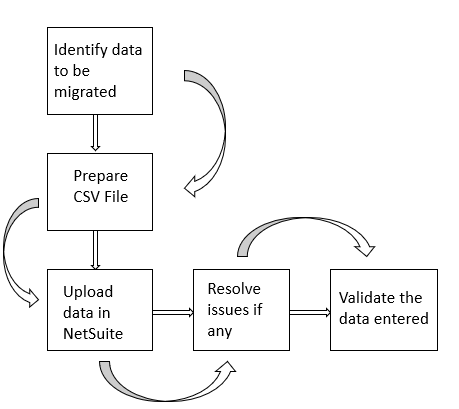NetSuite Data Migration is a complex process comprised of various challenges like redefining your company's information architecture.
NetSuite data conversion and migration across cloud and on-prem enterprise systems to NetSuite ERP is critical for customers in the software, wholesale distribution, and high-tech industries.
Let’s delve into why businesses must adopt NetSuite Data Migration and the benefits.
Data Migration in ERP
Data migration for ERP implementation is the process of moving data from its original locations to the new ERP system's database. This frequently involves making data transfers in several formats, systems, and storage mediums into a single, centralized structure.
The Role of Data Migration in ERP Implementation
Our data is scattered and locked in different systems. Segregated data is all over the place, accumulating at a staggering rate. But data can be much more valuable when we get it all in the same place and get a consolidated view of our organization. We can then use information about our customers, products, and services to make faster, better, more informed business decisions, and unlock the full potential of our data.
Need for Data Migration
The most common reasons to adapt to Data Migration are:
- The obsolete nature of a previous system and data structure, previous ERP support termination, or the lack of data consolidation.
- The company usually stores client, product, partner, and supplier data in various formats and storage locations. ERP data migration often implies moving data into a single, intertwined system to ensure a more straightforward and quicker search and extraction of needed information.
- Many people inside the company rely on data integrity and continuity, mostly customers and suppliers. With the data in the existing setup being unpredictable at times, the outcome from the integrations may not be accuratedue to information redundancy and storage or file glitches.
- When your company implements a new enterprise resource planning (ERP) solution, the preliminary methodical data transfer is inevitable.
Key Points to Remember When Migrating Data
- The challenges of data migration include time, cost, issues with data redundancy and integrity, potential regulatory concerns, and stakeholder support.
- Successful ERP implementation hinges on the quality of your data migration strategy. It would be best if you had a dedicated team to analyze data, perform the migration, and evaluate the results.
- Best practices for ERP integration include starting early on the migration process to avoid delays in the ERP deployment. Data migration is also an opportunity to discover and remove obsolete historical data.
Why Choose NetSuite for Data Migration?
One of the main reasons why businesses choose NetSuite in addition to those that are listed below is that it gives you go live in a predictable timeframe. Smart, step implementations that begin with sales and span the entire customer lifecycle, so there’s continuity from sales to services to support.
- Reduce manual and spreadsheet-based processes.
- Gain daily cash balance visibility (help to control cash flow).
- Software-as-a-Service – One does not have to worry about in-house servers or information security, loading the software, updating until it is available in the cloud, etc.
- Real-time visibility across the business.
- 24/7 access from any browser.
- Updates from QuickBooks.
Steps to Building Your NetSuite ERP Data Migration Strategy
To ensure a successful data migration, businesses need to take a methodical approach, which typically includes inspecting, extracting, cleansing, and transforming the data from each of these applications before importing it into NetSuite.
- Ensure all data needed in the system is included in the upload file.
- Identify available fields to populate by creating a new manual entry in NetSuite.
- Identify mandatory fields required in the upload file.
- Understand what type of data you upload and how NetSuite works for that section.
- Prepare CSV files:
- Create a CSV file that includes 1 or 2 records as test upload.
- Ensure all data is accurate and complete when adding all columns and rows to the Excel file.
- Delete all blank columns and rows after the last row or Column of data.
- If the file is using numbers for data, change the format to numbers for data requiring numbers in Excel.
- Try to use the same field names in the Excel file as in NetSuite.
- Save the Excel file as a CSV file.
- Upload data in NetSuite.
- Resolve Errors if any are found in records.
- Validate the records for accuracy.
NetSuite Process Flow Diagram:

If necessary, follow the same process again.
ERP Data Migration Best Practices
- Prioritize data migration. Data migration is time-consuming and can delay your full implementation if you do not plan carefully. Near the start of the implementation, begin to create processes for extracting and cleansing data from source systems.
- Think about broader business use of the data. Before starting the migration, spend time thoroughly analyzing your existing data, thinking about how it will be used within the ERP system, mapping it to the structure of the ERP database, and setting up rules for translating the data to the new structure during migration.
- Assign data governance responsibility. Determine who owns which data and assign roles to your team. For example, the team will have to determine which version of redundant customer information is correct and should be incorporated into the ERP system.
- Be selective with data. You may be tempted to hoard data, importing every piece from your old systems into the ERP system in the belief that it may be needed one day. But not all historical data needs to be immediately accessible or valuable. Some businesses may elect to store historical data that they do not migrate in a separate system for historical analysis or other use, if required.
Jade is a leader in offering seamless NetSuite Data Migration
Jade has nearly two decades of experience implementing solutions that span CRM, ERP, Microsoft, Managed Services, Analytics, Information Management, and Big Data. Our domain knowledge, system expertise, and technical skills enable us to effectively implement, optimize, and maintain your NetSuite system. Flexibility to adapt and respond to your changing business needs is in our DNA, and we effectively handle fluctuating workloads without changes in implementation costs.
We have prebuilt, defined templates and data models from past integration solutions that we can immediately deploy on your projects.
At Jade, we have developed seamless NetSuite Data Migration best practices that enable you to incorporate NetSuite ERP without disrupting your operations.
We are experts in NetSuite data conversion and migration across cloud and on-prem enterprise systems to NetSuite ERP. We have successfully delivered end-to-end NetSuite Data Migration in ERP implementations for customers in the software, wholesale distribution, and high-tech industries.
For more information, you can connect with us at the following link: contact us













